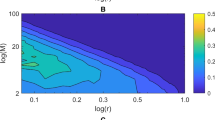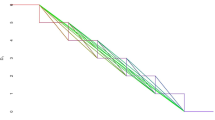Abstract
This paper presents a short-run model of price competition for markets defined as networks (node-linkage associations) under perfectly inelastic consumer demand. Analytical and simulation analyses show an inverse relationship between firms' equilibrium price schedules and the number of directly connected rival firms. As the degree of network connectivity increases, holding the size of the overall market constant, average equilibrium mill prices tend to decrease at a decreasing rate. This implies that the intensity of competition in a network increases as the network becomes more fully connected, and equilibrium price levels converge at some theoretical minimum that is specific to the prevailing market conditions. Price-connectivity relations are shown to be highly sensitive to network structure and the distribution of price conjectural parameters. In addition, the paper briefly discusses the welfare implications of price reductions from an accessible and cost-efficient firm in a network.
Similar content being viewed by others
References
Benson, B. L. 1979. Spatial microeconomics: implications for the use of concentration ratios to represent monopoly power.Review of Regional Studies 9: 1–15.
Benson, B. L. 1984. On the ability of spatial competitors to price discriminate.Journal of Industrial Economics 33: 251–55.
Benson, B. L., and Faminow, M. D. 1985. An alternative view of pricing in retail food markets.American Journal of Agricultural Economics 67: 296–306.
Benson, B. L., and Faminow, M. D. 1988. The impact of experience on prices and profits in experimental duopoly markets.Journal of Economic Behavior and Organization 9: 345–65.
Benson, B. L., and Faminow, M. D. 1990. Geographic price interdependence and the extent of economic markets.Economic Geography 66: 47–66.
Boyer, M., and Moreaux, M. 1984. Equilibres de duopole et variations conjecturales reactionelles.Canadian Journal of Economics 7: 111–25.
Bresnahan, T. 1981. Duopoly models with consistent conjectural variation.American Economic Review 71: 934–45.
Capozza, D. R., and Van Order, R. 1989. Spatial competition with consistent conjectures.Journal of Regional Science 29: 1–13.
Economides, N. 1986. Nash equilibrium in duopoly with products defined by two characteristics.Rand Journal of Economics 17: 431–39.
Faminow, M. D., and Benson, B. L. 1985. Spatial economics: implications for food market response to retail price reporting.The Journal of Consumer Affairs 19: 1–19.
Faminow, M. D., and Benson, B. L. 1990. Integration of spatial markets.American Journal of Agricultural Economics 70: 49–62.
Fik, T. J. 1988. Spatial price competition and retail food price reporting.Economic Geography 64: 29–44.
Fik, T. J., and Mulligan, G. F. 1991. Spatial competition: a network approach.Geographical Analysis 23 (forthcoming).
Gabszewicz, J., and Thisse, J.-F. 1986. Spatial competition and the location of firms. InFundamentals of pure and applied economics, eds. J. Gabszewicz and J.-F. Thisse pp. 1–71. Amsterdam: North-Holland.
Hanjoul, P., and Thill, J.-C. 1987. Elements of planar analysis in spatial competition.Regional Science and Urban Economics 17: 423–39.
Mulligan, G. F., and Fik, T. J. 1989a. Price variation in spatial oligopoly.Geographical Analysis 21: 32–46.
Mulligan, G. F., and Fik, T. J. 1989b. Price variation in spatial markets: the case of perfectly inelastic demand.The Annals of Regional Science 24: 187–201.
Mulligan, G. F., and Fik, T. J. 1989c. Asymmetrical price conjectural variation in spatial competition models.Economic Geography 65: 19–32.
Okabe, A., and Aoyagi, M. 1990. Existence of equilibrium configurations of competitive firms on an infinite two-dimensional space.Journal of Urban Economics 28 (forthcoming).
Okabe, A., and Suzuki, A. 1987. Stability of spatial competition for a large number of firms on a bounded two-dimensional space.Environment and Planning A 19: 1067–82.
Read, C. 1989.Some results on the hotelling problem in two dimensions — minimum differentiation once again. Fairbanks: University of Alaska, School of Management Working Paper 3.
West, D. S. 1981a. Testing for market preemption using sequential location data.Bell Journal of Economics 12: 129–43.
West, D. S. 1981b. Tests of two locational implications of a theory of market preemption.Canadian Journal of Economics 14: 313–26.
West, D. S. 1989. Evaluating a supermarket relocation strategy using spatial competition analysis.The Annals of Regional Science 23: 137–54.
Author information
Authors and Affiliations
Rights and permissions
About this article
Cite this article
Fik, T.J. Price competition and node-linkage association. Papers in Regional Science 70, 53–69 (1991). https://doi.org/10.1007/BF01463443
Issue Date:
DOI: https://doi.org/10.1007/BF01463443




